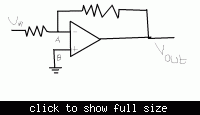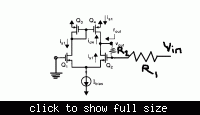engrMunna
Advanced Member level 4

When analysing op-amps as a block diagram like in fig1 we say that because node B is at ground so node A will also be at ground
but when i look at the equivalent model of the op amp at transistor level in fig 2 I can't see how making Vin- ground will
make Vin+ at ground too??
And the second thing I dont get is that if in fig2 Q1 gate is grounded (small signal ground) wont this make Vgs (small signal) negative.
Thanks


but when i look at the equivalent model of the op amp at transistor level in fig 2 I can't see how making Vin- ground will
make Vin+ at ground too??
And the second thing I dont get is that if in fig2 Q1 gate is grounded (small signal ground) wont this make Vgs (small signal) negative.
Thanks




